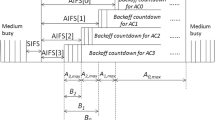Abstract
Popularity of IEEE 802.11 networks has increased dramatically over the past number of years. Nowadays audio/video conferencing, gaming and other quality of service (QoS) sensitive services are being delivered to the end users over wireless. Commonly probability for a packet to overstay a specific timeout serves as a QoS metric, and obtaining media access control layer packet delay distribution is highly important for this QoS prediction. Usually wireless devices are equipped with energy supplies of limited capacity, and accurate estimation of their energy expenditure is essential from the network design point of view. Meanwhile, as packets of longer delay normally have higher energy transmission cost, there is a certain dependency between the two metrics. This paper considers internal structure of the metrics and proposes a mathematical model that allows obtaining their individual distributions together with the joint distribution. The model presents a random sum, where the summand formation is determined by a Terminating Markov Process. The model has been validated through comparison with results of NS3 simulation.










Similar content being viewed by others
References
IEEE 802.11 Working Group. (2007). Wireless LAN medium access control (MAC) and physical layer (PHY) specifications. USA: The Institute of Electrical and Electronics Engineers, Inc.
Chen, Y., Zhang, S., Xu, S., & Li, G. (2011). Fundamental trade-offs on green wireless networks. IEEE Communications Magazine, 49(3), 30–37.
Bianchi, G. (2000). Performance analysis of IEEE 802.11 distributed coordination function. IEEE Journal on Selected Areas in Communications, 18(3), 535–547.
Ergen, M., & Varaiya, P. (2008). Throughput analysis and admission control in IEEE 802.11a. IEEE Transactions on Vehicular Technology, 57(1), 436–447.
Zheng, Y., Lu, K., Wu, D., & Fang, Y. (2006). Performance analysis of IEEE 802.11 DCF in imperfect channels. IEEE Transactions on Vehicular Technology, 55(5), 1648–1656.
Lu, K., Wang, J., Wu, D., & Fang, Y. (2009). Performance of a burst-frame-based CSMA/CA protocol: Analysis and enhancement. Wireless Networks, 15(1), 87–98, ISSN: 1022-0038.
Tainaka, T., Masuyama, H., Kasahara, S., & Takahashi, Y. (2009). A Markovian approach to per-flow throughput unfairness in IEEE 802.11 multihop wireless networks. Journal of Industrial Management Optimization, 5(3), 493–510.
Hui, J., & Devtsikiotis, M. (2005). A unified model for the performance analysis of IEEE 802.11e EDCA. IEEE Transactions on Communications, 53(9), 1498–1510.
Taher, N., Doudane, Y., & El Hassan B. (2009). A complete and accurate analytical model for 802.11e EDCA under saturation conditions. In Proceedings of the IEEE/ACS international conference on computer systems and applications.
Tinerello, I., & Bianchi, G. (2010). Rethinking the IEEE 802.11e EDCA performance modeling methodology. IEEE/ACM Transactions on Networking, 18(2), 540–553.
Tainaka, T., Masuyama, H., Kasahara, S., & Takahashi, Y. (2011). Performance analysis of burst transmission mechanism for IEEE 802.11-based multi-hop wireless LANs. IEEE Transactions on Wireless Communications, 10(9), 2908–2917.
Qi, H., Malone, D., & Botvich, D. (2009). 802.11 wireless LAN multi player game capacity and optimization. In Proceedings of the the 8th annual workshop on network and systems support for games.
Huang, K., & Duffy, K. (2009). On a buffering hypothesis in 802.11 analytic models. IEEE Communications Letters, 13(5), 312–314.
Liu, R.P., Sutton, G., & Collings, I. (2010). A New queuing model for QoS analysis of IEEE 802.11 DCF with finite buffer and load. IEEE Transactions on Wireless Communications, 9(8), 2664–2675.
Zhao, H., Wang, S., Xi, Y., & Wei, J. (2010). Modeling intra-flow contention problem in IEEE 802.11 wireless multi-hop networks. IEEE Communications Letters, 14(1), 18–20.
Zhao, H., Garcia-Palacios, E., Wang, S., Wei, J., & Ma, D. (2013). Evaluating the impact of network density, hidden nodes and capture effect for throughput guarantee in multi-hop wireless networks. Ad Hoc Networks, 11(1), 54–69.
Tickoo, O., & Sikdar, B. (2008). Modeling queuing and channel access delay in unsaturated IEEE 802.11 random access MAC based wireless networks. IEEE/ACM Transactions on Networking, 16(4), 878–891.
Xie, L., Wang, H., Wei, G., Xie Z. (2009). Performance analysis of IEEE 802.11 DCF in multi-hop ad hoc networks. In Proceedings of the international conference on networks security, wireless communications and trusted computing, pp. 227–230.
Kafetzakis, E., Kontovasilis, K., & Stavrakakis, I. (2011). Effective capacity-based stochastic delay guarantees for systems with time-varying servers, with an application to IEEE 802.11 WLANs. Performance Evaluation, 68, 614–628.
Kafetzakis, E., Kontovasilis, K., & Stavrakakis, I. (2012). A novel effective capacity-based framework for providing statistical QoS guarantees in IEEE 802.11 WLANs. Computer Communications, 35, 249–262.
Brandwajn, A., & Begin, T. (2009). A note on the effects of service time distribution in the M/G/1 queue. In SPEC benchmark workshop, pp. 138–144.
Ivanov, S., Botvich, D., & Balasubramaniam, S. (2010). Joint throughput and packet loss probability analysis of IEEE 802.11 networks. In Proceedings of the IEEE symposium on computers and communications.
Ivanov, S., Botvich, D., & Balasubramaniam, S. (2011). On delay distribution in IEEE 802.11 wireless networks. In Proceedings of the IEEE symposium on computers and communications.
Hida, T., & Hitsuda, M. (1993). Volume 120 of translations of mathematical monographs: Gaussian processes. USA: American Mathematical Society.
NS-3.13. The NS-3 discrete-event network simulator. http://www.nsnam.org/. Accessed December 2011.
Author information
Authors and Affiliations
Corresponding author
Rights and permissions
About this article
Cite this article
Ivanov, S., Botvich, D. & Balasubramaniam, S. Joint delay and energy model for IEEE 802.11 networks. Wireless Netw 20, 1121–1132 (2014). https://doi.org/10.1007/s11276-013-0669-7
Published:
Issue Date:
DOI: https://doi.org/10.1007/s11276-013-0669-7




